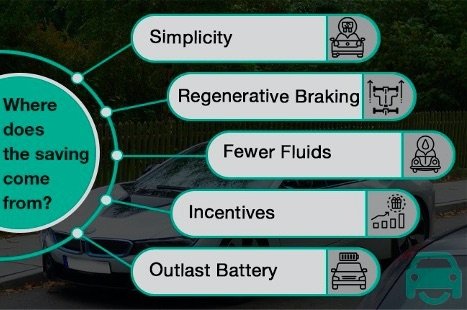How Expensive Is EV Maintenance?

Are you the proud owner of an electric vehicle (EV), or are you about to purchase one? If so, this guide helps you to understand what it takes to keep EVs in good condition. You’ll appreciate your beloved electric car more once you know the tricks of how to save on maintenance costs.
What Parts of EVs Require Maintenance?
Electric vehicles are propelled with the aid of electric motors (traction motors), and they utilise electrical transmission systems. There are various sources of power that EVs can use: fuel cells, batteries, solar panels, electric generators, and off-vehicle sources. Let’s take a look at what the maintenance of power sources like batteries and other parts of an EV entails.
Batteries
Battery degradation in BEVs (battery electric vehicles) is a thing that might become a worry for many car owners and shoppers. Some manufacturers offer 8-year warranties for the batteries of their vehicles. Others may give 10 years. This is good enough and should keep you calm. Nonetheless, do your part to check the coolant level of the battery regularly. Get the battery serviced if you notice a significant depreciation in the battery range. Note this rarely happens.
Brakes and Tyres
Brakes
EVs have regenerative braking, which is regularly used instead of the vehicle’s disc brakes. Brake pads on an electric car never need to be replaced for the lifetime of the vehicle because they are rarely used—meaning that there is reduced brake wear.
Tyres
Two factors that can cause the need for a tyre replacement are over-pressure and wear. Too much tyre pressure can lead to a reduction in lifespan, and electric car tyres wear faster than those of internal combustion engine (ICE) cars. This is because EVs are typically heavier than conventionally fuelled vehicles. It is up to the car owner to prevent the need for a replacement caused by over-pressure.
Windscreens, Wiper Blades, and Washer Fluid
The windscreens of EVs can get cracked or chipped just like those of ICE cars. They also have wiper blades which may need replacing when worn out. Washer fluid needs to be topped up regularly.
General Wear and Tear
Electric vehicles have many other components that require regular/periodic maintenance or may need occasional repairs due to wear and tear—apart from the ones discussed above. Those components include the cabin air filter, door locks, airbags, power steering, suspension, coolant circuits, etc.
So, Exactly How Expensive is EV Maintenance?
Traditional vehicles feature more moving parts than electric drivetrains. Therefore, the annual total cost of maintaining your EV will be lower than that of a regular vehicle. You can spend any amount from a half to a third of the average cost of ICE vehicle maintenance on taking care of your electric car. This depends on the make and model of the EV. Check the following points for more on maintenance costs.
A Consumer Reports study discovered that non-electric cars require about £6,905 on average for lifetime maintenance and repairs. At the same time, both BEVs and PHEVs (plug-in hybrid electric vehicles) only need about £3,452.
BEV battery replacement/repair costs vary depending on the manufacturers. New batteries can cost between £3,700 and £7,500.
Where Does The Saving Come From?
Owning an electric car means you get to save on gas while reducing your carbon footprint. There are other opportunities to save when it comes to EVs maintenance, as described below.
Simplicity
As stated earlier, EVs have fewer moving parts than conventionally fuelled vehicles. Most electric cars have a simple structure of three main elements where the most investment in maintenance is needed, namely the onboard charger, the inverter, and the engine. This means EV owners will spend less on lifetime maintenance and repair costs. You don’t need to worry about oil and spark plug changes and the replacement of other parts related to emissions.
Regenerative Braking
Regenerative braking in electric cars helps their owners to save possibly half the money that would have been put into the maintenance of ICE vehicle brakes.
Fewer Fluids
EVs have far fewer fluids to maintain than traditional vehicles. The fluids are generally sealed inside the infrastructure of the EV and are inaccessible. You will also be free from those regular purchases of petrol.
Incentives
There are additional incentives for owners of electric cars—for example, financial credit for swapping old battery packs for new ones. Owners of ICE cars can only benefit from avoiding costs of emergency repairs and penalties imposed for poor vehicle maintenance.
Outlast Battery
The average lifespan for traditional car batteries is between 3 to 7 years. On the flip side, EVs utilise batteries that can last for 8-10 years without needing to replace them, so you have a longer time before worrying about battery replacement costs.
Suppose you are thinking about OBD2 (on-board diagnostics) tools for your electric car. You might not need to, as they are becoming increasingly less important due to advancements in the area of remote diagnostics. OBDII diagnostics data have become unnecessary for most electric car repair and maintenance services. The use of OBDII ports has been greatly reduced, so there may be savings from not needing to buy scan tools or visiting a garage for repairs.
Final Thoughts
An EV with cutting-edge technology is pricier to buy than a regular car. However, the cheaper maintenance can close that gap. Savings over the life of an EV is a big reason why it’s worth investing in.
So, if you already own an EV and you are looking for a place to get your electric car taken care of, sign up for a free MotorEasy account today.





